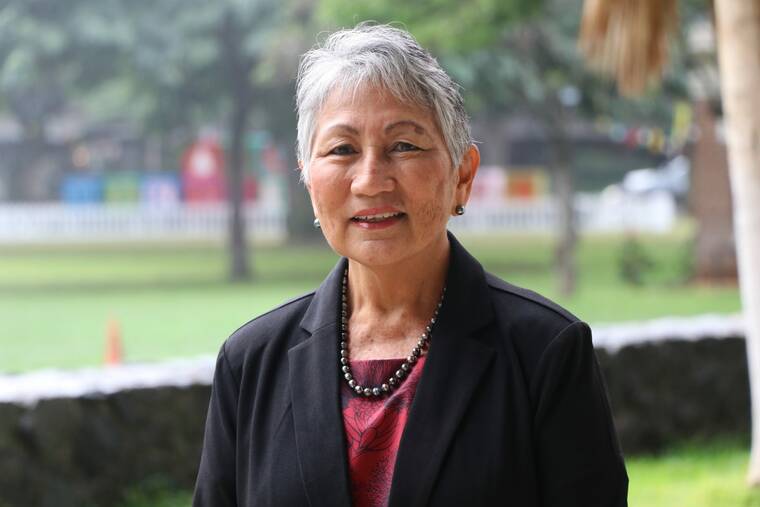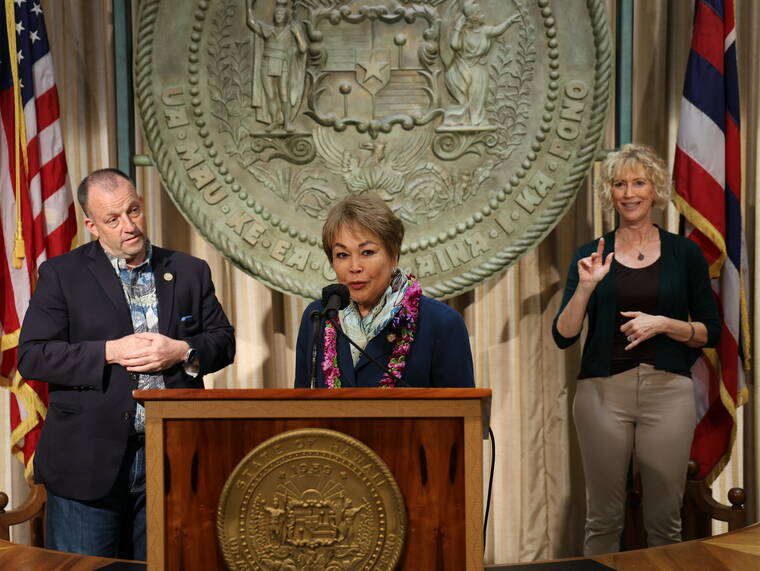Major state land shift underway: With food production as the goal, parcels are being transferred from DLNR to DOA

CHANG

Gov. Josh Green looks on Thursday as state Sen. Lorraine Inouye discusses aspects of a state land transfer.
Gov. Josh Green said Thursday his administration has made major steps toward putting more state-owned land into agricultural production.
Gov. Josh Green said Thursday his administration has made major steps toward putting more state-owned land into agricultural production.
In a press conference in Honolulu, Green said Department of Land and Natural Resources and Department of Agriculture chairwomen Dawn Chang and Sharon Hurd have over the past few months identified DLNR-managed hands that can be transferred to the DOA for agricultural leases to farmers and ranchers.
Those transfers would take place under Act 90 — a 2003 law resulting from legislation penned by state Sen. Lorraine Inouye, a Hilo Democrat. The statute allows for the transfer of the lands with or without leases, with the approval of both the state Board of Land and Natural Resources and state Board of Agriculture.
To date, 24,200 thousand acres of agricultural land have been approved and transferred by DLNR to the DOA.
In October, the Board of Agriculture approved accepting 99 more parcels on the list, totaling 21,672 acres, which still requires the review and approval of the BLNR.
“Honestly, we’ve tried to enhance our capacity to move land into the ag space, so we can enhance food security,” Green said. “Without farms, we just don’t have food for our people, and that’s what we’re about.”
According to a Nov. 19, 2018, article in U.S. News and World Report, Hawaii imports about 85% of its food despite a year-round growing season. That makes the state vulnerable to dock strikes and Pacific hurricanes.
“This act says a couple of things,” Green said. “No. 1, that we’ve got to conserve and protect our ag lands. Two, we have to promote diversified agriculture. … And that means … cultivating the land.
“It’s been a long time since we’ve seen big movement on this.”
Green described the majority of the land under consideration for transfer as “very heavily on the Big Island,” but he did not provide specifics. A request by the Tribune-Herald for the amount of acreage on each island being considered for transfer was not answered in time for this story.
“We’re working on transfer of approximately, over time, up to 110,000 acres which are eligible for transfer under the statute,” he said.
Chang said she and Hurd have agreed to a smaller but sizable transfer at this time.
“I don’t have the exact numbers, but I think we estimated about 70,000 acres total will be transferred that we mutually agree to,” she said. “The governor and his leadership really encouraged us to sit down and work together and implement Act 90.
“We have dual missions. We have the mission … to increase food production. We also have the mission to continue to preserve and protect very important watershed lands, forestry lands. But there’s an opportunity to do both of that on Act 90.”
Chang said she had the opportunity to visit KK Ranch and Kapapala Ranch on Hawaii Island and was “extremely impressed.”
“They are good stewards of the land. They are taking care of the land,” she said. “They can do both food production as well as manage our forest lands. So, with that opportunity to witness for myself the good work that these ranchers are doing, I was very comfortable with working with Chair Hurd on transferring many more of those lands.”
Hurd said the transfers will increase the amount of land available for farming and ranching, “but what we lack is production.”
“More than 90% of the 7,328 farms in the state are small farms, less than nine acres,” she said. “This … transfer puts parcels that are far bigger, larger than the nine acres that marks a small farm. We can put so much more food into production. And we need to support production, which is lacking.”
Brian Miyamoto, executive director of the Hawaii Farm Bureau, said recent actions “have moved the needle on Act 90, but there is much more that still needs to be done.”
“The success of ranchers and farmers is a key component to the state’s agriculture goals, such as doubling food production, farm-to-school and the many other goals that we want — food sustainability, food security. We need production on agricultural lands,” he said. “Farmers and ranchers need long-term leases to prudently invest in infrastructure improvements in leased lands. DOA’s rules are set up to encourage agriculture and make it practical to do so.”
Nicole Galase, managing director of the Hawaii Cattlemen’s Council, said Act 90 “is not taking land away from conservation.”
“It’s actually keeping agricultural land in production, and giving these leaseholders the confidence that they’ll stay in business,” she said. “The business of cattle production is one that must include land management. This includes conservation. They have been investing millions of dollars into things like invasive species removal, fencing, water systems. These are all practices in infrastructure that extend their benefit to the wider public, all while also producing food.”
According to Galase, the Hawaii Cattlemen’s Council has secured almost $3.5 million in grants from the Natural Resources Conservation Service, the Hawaii Climate-Smart Commodities and the Grazing Lands Conservation Initiative “so that we can help these ranchers do the conservation practices they need while they’re producing food.”
According to Inouye “20 years of delays has been a long time” to fully implement the law she penned.
“The goal at that time — when we worked on this legislation of Act 90 — was to preserve the lands, but also for food sustainability,” she said. “However, as we are in 2024 … food security and farm-to-school has been added, all due to the diligence of our legislators.”
Email John Burnett at jburnett@hawaiitribune-herald.com.


